| New Products |
|
|
| |
|
Operating Strategies |
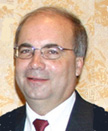 |
|
Bob Niemiec |
Preparing to Win with AR
I have always been amazed by the rather low penetration rate of anti-reflective lenses in this country. With AR lenses selling at rates of over 90 percent in some Asian and European countries, the rate here in the U.S., is still between 25 and 30 percent, although it is increasing slowly. The relatively low penetration was understandable five or ten years ago, when AR lens performance was still often problematic. Dispensing opticians were reluctant to recommend and sell an add-on product that could cost between $50 and $100 but would smudge and scratch easily, or even delaminate from the lens substrate.
However, most of the AR lenses being produced today exhibit performance and wear characteristics that are head and shoulders above the AR products of even a few years ago. Given the benefits to the customer, the dispenser and the producing lab, the current low rate of sale is mystifying. At all levels of the market, AR remains a vast and largely untapped potential win.
It's easy to see the bottom line “win” that increasing AR sales can produce. To truly “win” with AR, though, requires the “will to prepare to win.” Have you made the necessary investment in training, equipment, and process control in your surfacing area to make sure that every lens to be AR coated is as pristine as possible? If you are currently coating product, have you made similar investments in training and process control in your coating area? In the finishing area, have you made the necessary investment in people, processes, technology and equipment to ensure that AR lenses have a high probability of meeting customer expectations the first time they're ready to ship?
The opportunity to “win” with AR in terms of customer benefit and financial reward for those who produce and sell the product should be very apparent. The question is, do you have the will to prepare to win?
—Bob Niemiec is president of Optinova Solutions, LLC, a consulting firm specializing in operations improvement, new technology assessment and mergers and acquisitions, primarily in the optical industry. An optical industry veteran, he has held senior level positions in manufacturing and distribution with large optical retailers and manufacturers. He can be reached at
[email protected]. |
| |
|
Tech Talk |
|
Fining and Polishing Fundamentals,
Part 1
Fining removes excess lens material, marks left by the generator and put the final curve on the lens. It uses a lap tool, which matches the parameters on the job ticket. Polishing removes remaining imperfections and achieves optical clarity on the surface of the lens. Fining and/or polishing related errors include cracking, unwanted prism, pitting, chipping, warpage, waves, swirls and other distortions.
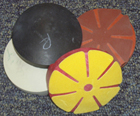
More components are involved in fining and polishing than any other surfacing step, including lap tools, pads, fining water and polish solutions and any problem with these parts will affect the whole lens. The stroke, which is the width of movement of the tool across the lens, is also a key factor. The stroke differs for materials and design. The stroke should be checked regularly throughout the day and the machine should be properly lubricated in order to maintain a consistent stroke. Unwanted prism, lenses cracking, chipping or pitting are typical indications of the stroke being off for fining. For polishing, warpage, waves and swirls indicate a stroke problem.
Pins are used to hold the block to the machine, and if the pins are misaligned, off-axis powers, waves and/or warpage can occur. Pins can also get dull and damaged, and bad pins will not hold the block correctly, causing spoilage. Check temperatures and quality of polish, which can become filled with debris from both the pads and the lens. If polish is too hot, the lens can warped, or if it is impure, a lens can become chipped and pitted. Remember, heat will damage lenses, especially high-index plastic and polycarbonate. Baumé, the percentage of solids to liquid in a medium, must be checked and guidelines followed. If the baumé is too thin, swirls and distortions will be created. If it is too thick, the lens will not polish clean and the lens will have to be re-blocked and polished again, risking spoilage and adding needless time to the job.
Fining water and polish that are not cool enough will warp lenses. Check your chillers, which maintain the temperatures of these solutions.
|
| |
|
HR Corner |
|
How to Effectively Handle
a Termination

Terminating an employee is one of the most difficult tasks a manager or business owner can undertake. A poorly handled termination can have a severe impact, leaving a disgruntled employee who might be tempted to litigate or file a civil rights violation claim. It also can mean low morale among the employees who remain and potential damage to the company's reputation.
Employers must always pay special attention to the actual
termination process. Here are a few helpful hints for you to consider when faced with an employee termination.
Setting up the meeting. Arrange a time to talk with the employee in person. Do not procrastinate once you have made the decision, except if you are awaiting counsel from your attorney or HR staff. Once the decision has been taken, decide the appropriate person to convey the termination message. This is most often the employee's immediate manager. All managers should be properly and thoroughly trained, coached and receive guidance about how to conduct a termination meeting.
Decide if it is appropriate to have a witness, such as a member of the human resources team, present. If there is a concern that the employee may be hostile or angry, a trained and experienced witness should be there to help de-escalate the situation and document the meeting. In the event you believe there may be the potential for violence, be sure to consider security issues, such as alerting building security and having them close at hand.
Meet in a quiet, neutral location. You should deliver the message in a neutral area, such as a conference room. Avoid conducting such meeting over lunch or dinner, or in a public place. You want to ensure that the conversation will be private. Also consider the day on which to meet with the employee. It is generally considered best to terminate an employee in the middle of a workweek rather than on a Friday. As well, avoid employee terminations around holidays or dates of significance to the employee, such as a known anniversary, birthday or family event.
Communicating the decision. The meeting with the employee should be brief, respectful, and to the point. The meeting needs only last long enough to communicate the decision and reason for the decision. You should engage in a candid, honest discussion about the reasons for the termination.
Never exaggerate. You should never exaggerate the employee's poor performance or over-justify the decision. Rather, be firm and direct, citing the decision, the reasons, and the information about what will happen next. And always refrain from disrespectful or intemperate remarks. You should remain calm and professional, and attempt to preserve the person's dignity. And take time to practice your remarks beforehand.
Address administrative issues. Be sure to discuss and have available all important administrative documents, like their final pay check, COBRA information, vacation pay, and other state and legally required information. Make sure to retrieve keys, badges, cell phones and all related company property. Equally important, ensure that all computer passwords and access have been properly secured or deleted, and that all ldquo;hard and soft filesrdquo; are identified and secured. Take a moment to review with and provide to the individual a copy of their signed Trade Secret, Confidentiality and Non-disclose Agreement.
Managing the transition. After the termination meeting, notify other staff members as soon as possible to prevent the spread of inaccurate or untrue information. Do not communicate the reasons for the termination, but do ensure people understand that the person has transitioned from the company and who will assume their prior duties and responsibilities in the interim. If appropriate, you should notify customers and clients of a change in assigned staff and assure them of a smooth transition.
Terminating an employee is never easy and always offers challenges. However, you can handle terminations most effectively when you are properly prepared and have a well charted process in advance.
Hedley Lawson brings over 25 years of optical industry experience to Jobson Medical LLC. For over 10 years, he has been a contributing editor to VM, most recently as writer of the monthly column “Business Essentials.” He is the Contributing Editor of VM's E-Newsletter
Business Essentials. |
|
 |
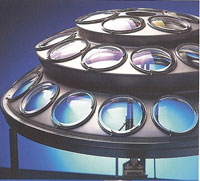
Considering the Cost of In-House AR,
Part 3
Does in-house AR make any money? For our subject lab, it did, and the results might shock some. The lab had a remarkable increase in gross profit from AR even only having the AR unit fully operational for 10 months of 2007. True there were some problems early on: training staff, spoilage, equipment, and flow issues, but for this lab they were well worth it!
In our analysis we only reviewed coating sales, coating costs, and surfacing costs to determine gross profit margins on AR coated jobs to keep lens margins from distorting the results. Below is a table comparing 2006 and 2007 AR coating results:
|
| 2006
| 2007 |
| In-house AR JPD
|
0
|
46 |
| Gross Profit % |
0% |
49.88% |
Outsourced AR JPD
(surfaced in-house) |
35
|
12 |
| Gross Profit % |
34.70%
|
34.89% |
Outsourced AR JPD
(surfacing outsourced) |
35
|
26 |
| Gross Profit % |
0.00%
|
(1.01%) |
| Total AR JPD |
70
|
84 |
| Gross Profit % |
18.02%
|
28.85% |
Not only did total AR coatings increase by 20 percent, but overall gross profit on AR coatings increased by 60 percent. Another obvious and alarming point is that the lab's jobs where the surfacing was outsourced made no gross profit at all. Keep in mind that lens costs and sales were not included in this analysis. Because of the soft economy, net sales dollars for the lab declined in 2007 compared to 2006 by 4.6 percent, and AR coating net sales dollars declined by 5.8 percent.
The one year return on investment was 16.46 percent and that was only with 10 months of in-house AR operations. At that rate the payback on the investment will be about 6 years, but the lab anticipates in-house AR profit's to continue their rise and payback will be even sooner. The lab is ecstatic because even though they made the investment in a down year when their sales were lower, their overall profits were higher than the previous year. The lab's turnaround time on AR work decreased substantially, and they are controlling the process. The lab can also tell customers they are a true “full service” lab.
Although the performance of this lab was terrific, the project wasn’t without risk. The owners made a big gamble by investing a huge sum of money; mostly borrowed. Another point that needs to be made here is that there was still good profit in outsourcing much of their AR coatings, at least when the job was surfaced by the lab.
Read “Considering the Cost of In-House AR, Part 2.”
Read “Considering the Cost of In-House AR, Part 1.”
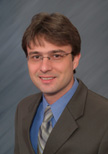 —Jason A. Meyer is senior vice president, HPC Puckett & Company. Based in San Diego, Calif.,
HPC Puckett & Company specializes in mergers and acquisitions of wholesale optical laboratories. You can send comments or questions about this article or any other Dollars & Sense articles to Jason Meyer at
[email protected]. —Jason A. Meyer is senior vice president, HPC Puckett & Company. Based in San Diego, Calif.,
HPC Puckett & Company specializes in mergers and acquisitions of wholesale optical laboratories. You can send comments or questions about this article or any other Dollars & Sense articles to Jason Meyer at
[email protected].
|
 |
| |
|
 |
|
The Case of the Nearsighted Colonel 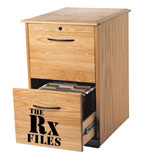
“We recently got a call for a job at 4:00 p.m.,” recalled Rick Lewis, director of lab operations at
Reliable Optics, a Brooklyn, New York wholesale lab. “The job on a super hot rush for an Army colonel who was leaving for Iraq the next day.”
The nearsighted colonel needed a -5.50D progressive with a 1.25 add. The account brought his frame to Reliable, which then surfaced his prescription using an in-house progressive. The only problem was the lenses needed to be AR coated.
“We had already put though our last AR run of the day,” said Lewis.
“Fortunately, our AR tech she stayed overtime to do the job.”
After the lenses were AR'd, edged and mounted in the frame, Eddie Purman, Reliable Optics's co-owner, dropped the job off at the account's store at 8:30 p.m., a half-hour before closing time. The colonel was waiting. The next day, he flew off to Iraq with his glasses.
“We lost money on this job, because we put through a whole AR run with only three pair of lenses,” said Lewis. “But by providing that kind of service, we may have gained a customer for life.” |
 |
| |
 |
|
Dana Morrison of Chitwood Optical
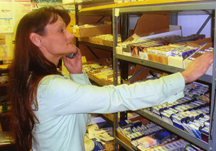 Dana Morrison has been with Chitwood Optical, an independent wholesale optical laboratory located in Fayetteville, Arkansas since February of 2000. She was originally hired for one week to fill-in for a staff member who was away at a meeting. “After two weeks of solid work,” Morrison commented, “I quit asking if I should come in the next day. I have been here ever since!” Dana Morrison has been with Chitwood Optical, an independent wholesale optical laboratory located in Fayetteville, Arkansas since February of 2000. She was originally hired for one week to fill-in for a staff member who was away at a meeting. “After two weeks of solid work,” Morrison commented, “I quit asking if I should come in the next day. I have been here ever since!”
Chitwood Optical is unique as there are no titles or job positions. All of the employees work side-by-side everyday, including the owners, Rick and Ann Chitwood. “Even though they are the boss, they allow us to do our jobs our way as long as it works well and the quality expected is in place,” said Morrison. Each staff member has their own departments, but is cross trained to help wherever may be needed. Morrison also commented about Chitwood Optical's encouragement of the staff to offer thoughts and opinions to help with the running of the lab.
Morrison started in the lab industry at Ozark Optical Lab, located in Springfield, Missouri in the late 1980s when everything was a clear, PGX, or plastic lens. Shortly after she left her job to raise her children. After being “completely out of the optical loop” for a decade, she returned to the optical industry and took a position at Chitwood Optical. “I was astonished to see how much things had changed in those 10 years,” Morrison said. “There was a lot to learn as there were many new choices of materials, seg styles and the fact that plastic was now available with Transitions as an alternative to glass PGX!”
Chitwood Optical is a small lab and is very hands-on. They do not have robotics, or belts carrying trays from station to station. “Things are pretty laid back and easy going here at Chitwood Optical,” Morrison noted. She spends her day putting jobs in trays, pulling stock and computing them. She also handles stock lens orders, special orders and meeting with vendors. Morrison reports the favorite part of her job to be working in the lens room. She enjoys learning about all the lenses available and helping doctors and opticians find the right lens for their patient. “We can do some amazing things. It's a good feeling to know you put out the best quality work and can stand behind it.”—Samantha Toth |
 |
| |
 |
|
Harbor Kicks Off Polarized Lens Promo
TRAVERSE CITY,Mich.—
Harbor Optical, an independent optical laboratory based here, has kicked off a new marketing program designed to help eyecare professionals increase their polarized eyewear sales. The new promotion, called Beach Bums, is designed to help practices realize the importance of polarized lenses sales as a way to increase patient satisfaction, while at the same time, growing the practice’s bottom line.
“We strive to not only provide exceptional service and products to practices, but also identifying ways to partner with the practices we work with to help them grow,” said Geff Heidbrink, president of Harbor Optical. “The Beach Bums promotion is a great way to encourage supplemental eyewear sales by providing eye care professionals with a reward for their efforts.”
The Beach Bums program started January 1, 2008 and will run through May 31, 2008. During this time, Epps are eligible to receive an entry ticket into the grand prize drawing for each pair of polarized lenses sold. If the polarized lenses are a second pair eyewear sale and are ordered at the same time as the primary pair, a bonus of two tickets will be awarded. These tickets are sent back to the ESP's office with the finished lenses.
The Grand Prize includes four VIP tickets to the Traverse City Beach Bums baseball game, a two-night hotel stay and a $100 gift card for meals. When the ECP receives the tickets, they fill them out with their contact information and return it to Harbor Optical to be entered. All ticket entries must be sent and received by Harbor Optical no later than June 13, 2008. The drawing for three Grand Prize winners will take place the morning of June 16, 2008. For more information call (888) 251-2040. |
| |
 |
|
Essilor Buys Majority Stake in Three Rx Labs in U.S., Acquires Italy's Galileo—Essilor of America, a subsidiary of Essilor International, has strengthened its U.S. prescription laboratory network with the acquisition of a majority stake in Empire Optical of California, Inc., located in North Hollywood. A distributor of Varilux lenses, the company has 168 employees and $23 million in full-year revenue.
Essilor of America has also acquired a majority stake in two other prescription laboratories: Advance Optical Sales Co., Inc. in Rochester, N.Y., with revenue of $6.1 million, and Future Optics in Jackson, Tennessee, with revenue of $3.3 million.
In Addition, Essilor has stepped up its development in Italy with the acquisition of Galileo, a major player in the Italian market. The company sells prescription and stock lenses under its own brand. Galileo operates a prescription laboratory in Milan and generates €13 million in annual revenue.
Tri-Supreme Launches Web Site—Tri-Supreme, the Farmingdale, N.Y.-based wholesale lab, has launched
www.trisupreme.com a new Web site offering complete and comprehensive lens availability updated weekly.
“Trisupreme.com has all the information you want and need 24/7,” said Mark Cohen, Tri-Supreme's training and marketing manager. “Our Web site is much different than any other optical lab Web site you may have visited.”
Among the site's features is complete and comprehensive lens availability and spec sheets on progressives, intermediate progressives, photochromic plastic, high-index, polarized, polycarbonate, Trivex and plastic lenses; printable and downloadable progressive cutout charts and the latest Crizal availability and photochromic plastic availability charts; a virtual lab tour; Tri-Supreme’s latest promotions and newsletters; Tri-Supreme University, a series of educational papers written by the staff of Tri-Supreme Optical, and a collection of tips and tricks for using Remo, Tri-Supreme’s online Rx-ordering software.
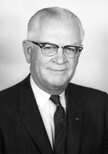 |
|
Jack Robertson,
founder, Robertson Optical Laboratories |
Robertson Optical Laboratories Marks 50th Anniversary—Independent wholesaler
Robertson Optical marks its 50th anniversary this month. The company’s original location in downtown Atlanta was opened April 14, 1958 by Jack Robertson, an optical lab veteran who started in the business in 1920. Robertson Optical's 11 employees serviced 22 prescriptions that first day and 149 the first week.
Through the years, Robertson Optical has owned labs in Atlanta, Ga.; Greenville, S.C.; Columbia, S.C.; Charlotte, N.C.; Albany, Ga.; Orlando, Fla. and Chattanooga, Tenn. In total, the company has occupied at least 15 buildings. Robertson Optical has filled millions of lens prescriptions, sold a multitude of eyeglass frames, sold contact lenses, developed the first one-step fining pad for grinding plastic lenses and started a separate company that designed and sold jumbo lens trays and Frame-o-Flex frame drawer dividers.
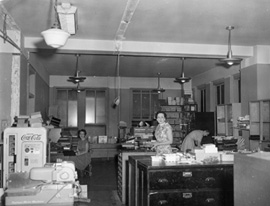 |
|
Jack Robertson opened the first location of Robertson Optical Laboratories in 1958 in downtown Atlanta, Ga. According to Jack's son Calvin, upon opening the laboratory, Jack said, "If we can receive 50 prescriptions a day, I'll be happy." This was achieved in the first six months. |
Today, Robertson is headquartered in Loganville, Ga. and operates branches in Columbia and Greenville, S.C. It employs 120 people, fills more than 7,000 prescriptions a week and serves customers throughout the southeastern and central states.
“When Jack Robertson started in the optical trade in the 1920s, little did he know the number of lives he would impact in the industry for future generations,” said Calvin Robertson, Jr., secretary of Robertson Optical of Atlanta (Loganville) and president of Robertson Optical of Columbia and Greenville, SC.
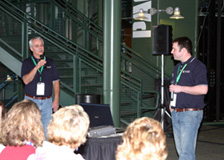 |
|
Joe Cherry, left, and Adam Cherry shared their opinions and experiences with the latest lens technology and discussed what to look for in 2008 and beyond. |
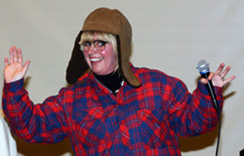 |
|
Lynn Schmidt of Wink Productions entertained her audiences as part of a fun and information program titled, "Everything I Learned About Patient Service, I Learned From Dairy Farming." |
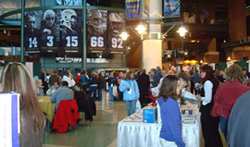 |
|
What's New University attendees check out the manufacturer's exhibits at Lambeau Field Atrium. |
Cherry Optical Hosts 2008 What's New University—Cherry Optical, an independently owned wholesale laboratory in Green Bay, Wisc., held its seventh annual What's New University (WNU) at Lambeau Field on March 1. Nearly 920 eyecare professionals attended the event, which featured 33 hours of educational programs.
Between five and nine programs were offered each hour over the four-hour CE portion of WNU. A wide range of courses were offered from an ABO exam prep course to how to sell a private practice to a current or future partner.
This year's program also featured an expanded exhibit area. The Lambeau Field Atrium floor provided 44,000 square feet of space which was filled with 95 exhibitors of frames, lenses, examination equipment providers and other related services available to independent eyecare professionals. As a special treat, attendees were able to walk down the same tunnel the Green Bay Packers use to enter Lambeau Field and have their picture taken on the “Frozen Tundra.”
Transitions Optical and Hoya Vision Care were major sponsors of the event. | |
 |
|
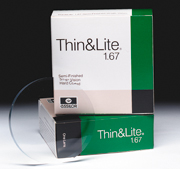
|
Varilux Comfort 360º
in Thin&Lite 1.67 and Thin&Lite 1.60
Manufacturer: Essilor of America
Description: High-index progressive lenses made with Essilor’s proprietary 360º surfacing technology
Features: Greater comfort and performance in a thinner and lighter lens. Thin&Lite 1.67 lenses are up to 34 percent thinner and 32 percent lighter than 1.50 plastic lenses and up to three times flatter than 1.50 plastic lenses for myopes. Easy to mount and edge, Thin&Lite 1.60 lenses are up to 30 percent thinner and 20 percent lighter that 1.50 plastic lenses.
Availability: Can be ordered with Crizal Avancé with Scotchgard Protector. Thin&Lite 1.67 Clear: Rx Range -12.00 to +8.00D, up to -4.00D cylinder; add power +0.75 to +3.50D; 1.75, 4.00, 5.50, 7.25, 8.50 base curves. Thin&Lite 1.60 Clear: Rx Range: -12.00 to +8.00D up to -4.00D cylinder; add power: +0.75 to +3.50D; 1.75, 4.00, 5.50, 7.25, 8.00 base curves. Varilux Comfort 360º lenses in Thin&Lite 1.67 and Thin&Lite 1.60 will also be available with Transitions VI later this year.
(800) 843-3937
www.essilorusa.com |
| |
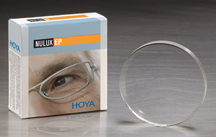 |
Nulux EP Bi-Aspheric Single Vision
Manufacturer/Distributor: Hoya Vision Care, North America
Description: Bi-aspheric single-vision lens
Target Customer: Discriminating single-vision lens wearers
Features/Functions: Clear vision from edge to edge, especially in oblique directions. Hoya’s patented Calculated Visual Acuity Power Correction Technology takes into account design customization across the entire surface of the lens through a point-by-point calculation, giving the Nulux EP Bi-Aspheric Single Vision lens an enhanced level of performance. Wearers will experience superior visual performance in all directions of sight and crystal-clear vision, Hoya reports.
Availability: 1.67 Eynoa and 1.70 Eyry materials with Hoya Super HiVision systematically included.
(972) 221-4141
www.hoyaopticallabs.com |
| |
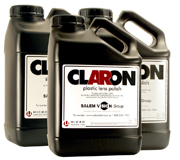 |
Claron Polish
Manufacturer/Distributor: Salem Vision Group
Description: Plastic lens polish
Features: Complex mixture of high-purity aluminum oxide particles in an aqueous suspension. The aluminum oxide employed is the product of precise particle engineering. This process creates a crystalline structure with the optimum particle size, shape and hardness.
Advanced fluid dynamics produces the supporting additives that control the dispersion and suspension of the aluminum oxide particles as well as enhance “cleanability” and suppress foam. A bonus for operators is the aqueous component, which provides a lotion-like effect on the skin.
(800) 234-1982
www.salemdist.com |
| |
|
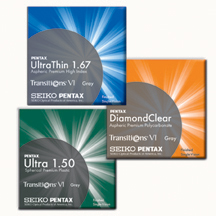
|
Seiko Transitions VI Lenses
Manufacturer/Distributor: Seiko Optical Products of America
Description: Three new finished single-vision lens products featuring Transitions VI photochromic technology.
Features: Transitions VI lenses are darker outdoors than Transitions V lenses and Transitions Next Generation lenses in any temperature, reducing discomforting and disabling glare; are clearer indoors than Transitions V lenses; and are faster to fade back than Transitions Next Generation lenses, according to Transitions. Transitions VI lenses also block 100 percent of UVA and UVB radiation—and now provide UV 400 protection. The lenses are available in all major lens materials and designs. Additionally, Transitions VI lenses are compatible with anti-reflective (AR) coatings from all major manufacturers. Combining Transitions VI lenses with an AR coating, improves the indoor clarity of the lens, reduces distracting glare and enhances nighttime driving.
Availability: UltraThin 1.67, DiamondClear polycarbonate and Ultra 1.50 plastic. The product range for the 1.67 index is -2.00 to -8.00D, and in polycarbonate +3.00 to -6.00D, both out to a -2.00 cylinder. Product range for 1.50 index is +3.00 to -4.00, to a -2.00 cylinder, with a total power of -4.00.
(800) 284-9051
www.seikoeyewear.com |
| |
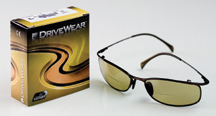
|
Drivewear FT 28
Manufacturer/Distributor: Younger Optics
Description: Drivewear flat-top bifocal 28 in hard resin
Features/Functions: Drivewear lenses combine Transitions Photochromic Technology and Younger's NuPolar polarization. Designed specifically to meet the visual demands of driving, Drivewear is the first polarized photochromic lens to darken behind the windshield of a car, which allows Drivewear lenses to change color based on current driving conditions in order to enhance the driver's vision. In addition, Drivewear lenses are polarized to block blinding glare.
Availability: Also offered in hard resin plano, single-vision and Younger's Image progressive.
(800) 877-5367
www.youngeroptics.com |
| | | | |
| In This Edition...
|
| |
|
•
Subscribe to Lab Advisor
The monthly update for Optical Laboratory Owners and Managers
•
Forward this issue of Lab Advisor to a friend or colleague
•
Print this issue of Lab Advisor
•
Stay on top of optical industry news!
Subscribe to our other
e-newsletters:
•
VMail Extra
•
Business Essentials
If you have lab news or want to share information about technical topics, please
contact us.
Or
contact
Andrew Karp,
Editor-in-Chief
Visit
LabTalkonline.com for additional articles of interest about labs. |
| |
| |
 |
| |
LabTalk Spotlight
April 2008
Continuing with digital surfacing theme in LabTalk's March/April issue, LabTalk editor, Christie Walker speaks out on the frustrations of digital surfacing technology and our industry.
Here's an excerpt:
“Do digitally surfaced lenses make it easier to see? A simple question on the surface (pun intended) but really now, are the lenses better? Let's step back and clarify a few things first before we answer that sticky question.
Digital surfacing is a process, not a product. The lens is the product. The product is composed of three elements: the material it's made from, the design/prescription, and several different coatings. That is the product. How you make the product is the process. Lens processing involves a bunch of machines and steps, which as lab owners and managers you know far better than I. And that’s the way it should be.
As a wearer of eyeglasses, I don't care how you make my lenses. I just want them to have the correct prescription, the polarized layer lined up horizontally (I have a pair that are crooked), and the AR coating applied so that I don't even know it's there. I want my lenses to be easy to keep clean and not to scratch the moment I put them on my face. What I don't care about is what went into accomplishing these results and neither does anyone else outside our industry.“
To read the entire article, "Straight Talk About Digital Surfacing* or whatever we are going to call it" log on to
http://www.labtalkonline.com/. Here you will find the article listed under the Features section.
|
|
Buying Group & Lab Association News
OLA Releases 2008 Progressive Identifier Book—OLA has released the 2008 edition of the OLA Progressive Identifier, the industry-standard guide to the identifying marks engraved on progressive addition lenses. Copies of the new edition are being shipped to OLA member labs.
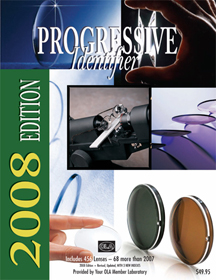
The 2008 edition contains diagrams for 456 lenses distributed in the U.S. and Canada, showing the markings that identify the lens supplier, the lens name, and the lens material. The diagrams include the relative position of the fitting cross, as well as the lens suppliers' recommended minimum fitting height.
The Identifier also contains six indexes, three of which are brand new for 2008. The indexes list the lenses according to: identifying symbols, lens supplier name, minimum recommended height, lens name, extended range of add power, and variable focus designs. The last three lists—newly added for 2008—make it easier to identify lenses, as well as to select appropriate lenses.
OLA distributes over 25,000 copies of the Progressive Identifier every year. OLA member labs are the customary distribution channel for the book; inquiries to OLA are typically referred to “your OLA member lab.” The online directory of OLA member labs is at
www.ola-labs.org, at the Member Lab Directory link. Copies are also available directly from OLA, by calling 800-477-5652.
OLA Donates 2007 Guide to Schools—“Optical laboratories have always maintained strong relationships with optometry and opticianry schools,” noted OLA executive director Bob Dziuban, “and OLA Members have extended that tradition to include their association's resources.”
With the release of each year's Identifier, OLA reserves the remaining inventory of the prior year's edition to be distributed to optometry and opticianry training programs. Instructors value the book for the insights it provides to the contemporary environment for premium lenses. Schools may request copies of the book in any quantity, whether a classroom set or student-body set. “We typically distribute several thousand copies each year,” said Dziuban.
“Labs have a long-standing tradition of providing education and resource material to their customers,” said Dziuban. “It's a logical extension of that philosophy to provide the same support to the schools that are providing optical education.”
Schools that want to obtain copies of the 2007 OLA PROGRESSIVE Identifier should contact the OLA office at 800-477-5652, or email to
[email protected]. | |
